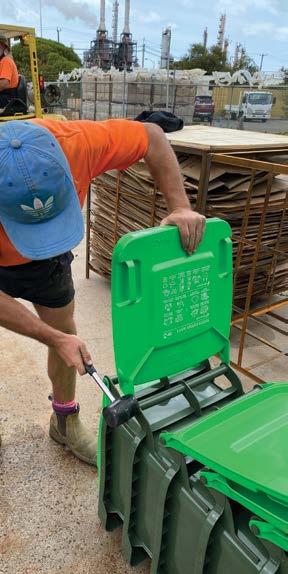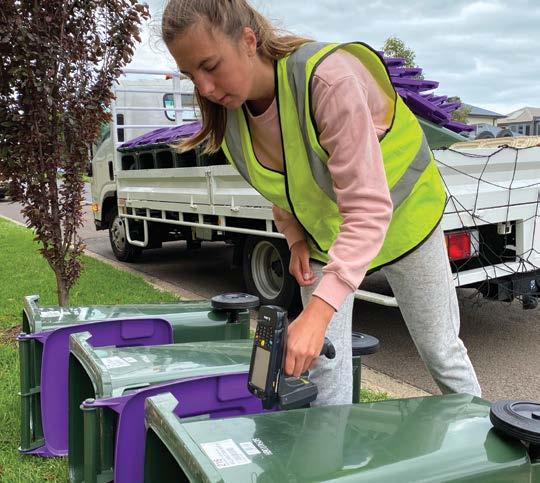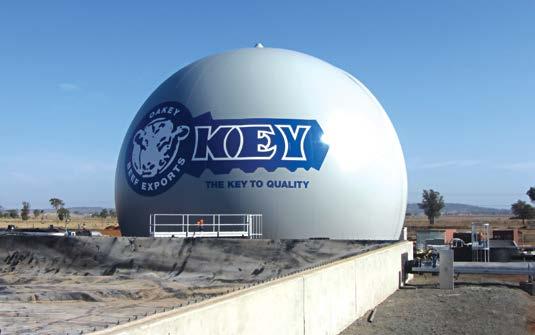
9 minute read
Cover Feature: MASTEC Purple Lid Glass Recycling Bins
RECYCLING 2.0 MASTEC rolls out new bins for Hobson Bay City Council’s new 4-bin residential collection service
Following the Victorian Government’s recent mandate for the introduction of a new 4-bin residential recycling and waste collection service for households across the state, leading Australian bin manufacturer MASTEC has rolled out some of the first new residential glass recycling bins for Hobsons Bay City Council in Melbourne’s inner south-western suburbs. As well as rolling out over 38,300 of the new distinctive purple-lidded glass recycling bins, MASTEC also delivered an additional 17,000 new 120 litre FOGO (Food Organics Garden Organics) bins, together with over 38,300 MASTEC® KO Kitchen Organics Caddy Bins to residences across the City as part of the Council’s new Recycling 2.0 initiative.
Advertisement

Hobsons Bay City Council is one of the first Victorian councils to adopt the new 4-bin residential collection system, which is a key component of the Victorian State Government’s $300 million 10-year Recycling Victoria package. Developed in the wake of the SKM recycling crisis, which impacted some 33 councils across Victoria, the Recycling Victoria package includes some $129 million of initiatives aimed at totally reforming kerbside recycling throughout the state.
The cornerstone of these reforms involves a move to expanded residential kerbside services featuring four colourcoded bins. By improving sorting and separation of waste, recyclables and organics at the source, the new 4-bin system will help simplify and streamline processing of each of the material streams. This, in turn, is expected to play a major role in helping to minimise contamination within the processed recyclables streams.
Although it is likely that individual bin capacities and collection schedules will vary between councils to meet the needs of specific communities, the four bins will feature ‘standardised’ lid colours for easy identifications, namely: • Purple Lid – Glass Recycling • Light Green Lid – FOGO (Food
Organics & Garden Organics) • Yellow Lid – Plastic, Metal and Paper
Recycling • Red Lid – Household Waste Most importantly, the new 4-bin system is not only expected to play a significant role in helping to reduce the amount of waste being sent to landfill across Victoria by an estimated 80% over the next 10 years, it will also provide a major catalyst

for the expansion of Victoria’s circular economy. Together with the obvious environmental benefits, this growth in the circular economy is expected create an additional 3,900 jobs in the sector over the next 10 years.

From left: Mayor of Hobsons Bay, Councillor Colleen Gates; Hobsons Bay City Council CEO Aaron van Egmond; (on right) Deputy Mayor of Hobsons Bay, Councillor Sandra Wilson; and Hobsons Bay City Council Director of Sustainable Communities, Pene Winslade; join representatives from Veolia, Cleanaway, Australian Paper Recovery (APR) and MASTEC to celebrate the launch of the city’s new Recycling 2.0 4-bin residential collection service.
have been supplied in the standard, neutral, ‘light bisque’ colour, enabling them to blend with the widest possible range of kitchen styles and colours.
In addition, approximately 17,000 households across the city that didn’t already have a green waste bin, were also provided with a new MASTEC® 120 litre FOGO bin with a lime green lid.
Bins for the roll-out were transported in bulk from MASTEC’s manufacturing facility in Adelaide to a temporary warehouse/storage yard which had been established in Altona, where the bins were fitted with lids, ready for delivery to the households. Every household also received an information pack with an easy-to-follow explanation of the new service and instructions on the correct use of each of the bins.
RECYCLING 2.0 – CHANGING THE FACE OF RESIDENTIAL COLLECTIONS Driven by last year’s recycling crisis, Hobsons Bay City Council accelerated the plans outlined in Council’s Waste and Litter Strategy 2025 to find a local, sustainable solution to meet its needs. The result is Recycling 2.0 - an innovative and sustainable waste and recycling service that has forever changed the face of residential recycling across the City.
The Recycling 2.0 service, which commenced on February 1 this year, focuses on maximising the recovery and local reuse of recycled kerbside materials. The new service separates food organics from general waste, combining them with garden organics in the new FOGO bin which is collected weekly. The introduction of a FOGO service is expected to reduce the volume of waste Hobsons Bay residents send to landfill by at least 20 per cent (approximately 8,000 tonnes per year).
With four bins per household, glass will also be taken out of the commingled yellow bin and placed into a dedicated glass recycling bin which is collected every four weeks. Without shards of broken glass in the paper, cardboard, metals and plastic bin, much better recycling outcomes can be achieved for all the comingled recycling products, including glass.
The residents’ existing yellow-lidded recycling bins will continue to be collected fortnightly, while their general rubbish bins (red lid), will change to a fortnightly collection.
Speaking about the new Recycling 2.0 services, Hobsons Bay Mayor, Councillor Colleen Gates, said that while the new system represents some changes in the city’s residential collection services - including an additional 4-weekly collection for recyclable glass and a reduction in the household waste collection from weekly to fortnightly - sorting waste and recyclables into four bins would be easy.
“We are committed to supporting our community in doing whatever we can to keep recyclable materials including glass and food waste out of landfill. Introducing a fourth bin is a practical way to do this,” the Mayor said.
“This innovative program recycles glass, paper, cardboard, plastic, metal, garden and food waste to create useful products, maximising the recovery and local reuse of materials and diverting them from landfill where they create harmful greenhouse gases,” Mayor Gates added.
ROLLING-OUT FOR A NEW SERVICE The new bins for Hobsons Bay City Council’s Recycling 2.0 services were rolled-out by MASTEC’s specialist Assembly & Delivery (A&D) teams in January. The roll-out saw some 38,300 households across the city provided with a new MASTEC® 120 litre Glass Recycling MGB (wheelie bin) with a distinctive purple lid, as well as a compact MASTEC® KO® kitchen caddy to assist with collection of food waste/kitchen scraps for the new FOGO service. The MASTEC® KO® Bins

HOT-STAMPED INSTRUCTIONS ALWAYS WITH THE BIN To further assist residents with the correct use of the new Glass Recycling and FOGO bins (including the MASTEC® KO kitchen caddy), the bin lids have been ‘hotstamped’ with clear graphic instructions as to what can and can’t be placed in each of the bins. As well as providing clear and concise instructions, the fact that the information is ‘hot-stamped’ into the lid means that unlike stickers which can fade, get damaged or come off the bin or lid, the usage information will always remain with the bin.
AUSTRALIAN MADE QUALITY As with all MASTEC® bins, the bins for Hobsons Bay City Council’s new Recycling 2.0 services are all manufactured in Australia at MASTEC’s state-of-the-art manufacturing facility in Adelaide. Specifically designed for harsh Australian conditions, their robust, UV stabilised construction plays a major role in ensuring that the bins are able to keep performing and looking good for many years. What’s more, their ‘standardised’ design utilises a number of identical components across the bin range (hinge pins, axles, wheels), thereby significantly reducing spare parts inventories and cost.


MASTEC® MAStrac HIGH-TECH BIN DELIVERY SYSTEM As anyone who has ever been involved with rolling out a new residential waste or recycling service will attest, it is a complex and often onerous task – especially when it involves the introduction of an additional bin. Registering bin serial numbers with property data, ensuring every household has the correct combination of bins and, importantly, making sure that the task is completed in time for the commencement of the new collection service(s), are all critical factors in the A&D process.
Put simply, failure in any of these areas can spell disaster for the council and collection contractor alike.
As well as being highly regarded for its high-tech manufacturing capabilities and the outstanding quality of its Australian made bins and lids, MASTEC has also gained an enviable reputation across Australia and beyond as an innovator and leader in the field of bin Assembly & Distribution (A&D) services.
The high-tech MASTEC® MAStrac bin delivery system utilises state-of-the-art hand-held scanners, together with a specially developed proprietary software package, to provide an extremely accurate and easy-to-use method of registering and tracking bin serial numbers and RFID tag numbers to individual properties. The purposedesigned system provides accurate, realtime information as to the status of every delivery, with the GSM-enabled scanners providing a constantly updated ‘live data stream’ during the rollout process.
As part of the bin manufacturing process, each MASTEC bin is also ‘hotstamped’ with a unique serial number and fitted with a matching barcode sticker. At the time of delivery to the individual households, the bins are fitted with a second barcode sticker which is generated by the MASTEC® MAStrac software as part of the delivery route sheet preparation process. This second barcode reflects delivery address, property ID number and the type and size of the bin.
With all of the relevant data now ‘physically attached’ to the bins by means of two barcode stickers, all that remains is for the delivery crews to scan the two barcodes and the RFID tag with the lightweight hand-held scanner/ transmitter. This is a quick and simple process that generally takes no longer than 10 seconds per bin to complete. The scanned data is then automatically transmitted (together with date/time stamp info) to MASTEC’s central database as a ‘combined’ record containing all of the relevant data for the bin.
Importantly, the fact that the data is scanned rather than written manually, helps to eliminate problems or issues relating to incorrect information being written down and/or illegible run sheets - further improving data integrity.
HIGHLY ACCURATE DATA As well as helping to provide a fast, efficient and streamlined Assembly & Distribution service, the MASTEC® MAStrac system has also proven itself to be an extremely effective method of verifying the accuracy of existing GIS rate / property data. For example, in instances where there may be a discrepancy in the GIS / property data provided for the rollout (e.g. no house at location, incorrect address or, more commonly, additional dwellings on sub-divided lots that have not been updated into the property database) the A&D operator is able to enter an exception code that provides a clear explanation as to why bins could not be delivered to the address, or conversely, why additional bins will be required at a specific address. In practical terms, once the rollout is finished, the completed MASTEC® MAStrac database not only provides a detailed database of the location of every bin asset, it also provides a highly detailed and extremely accurate property database – one in which every property has been physically located and identified, and any exceptions have been noted.
For further information on the full range of MASTEC products and services please phone: 1300 MASTEC (1300 627 832) or visit: www.mastec.com.au










